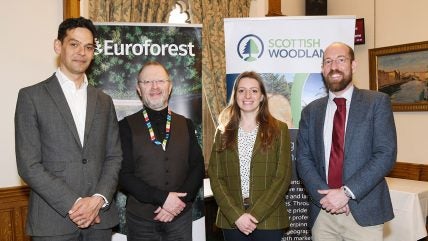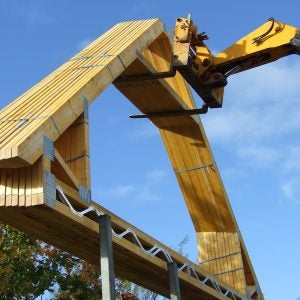
A panel discussion on ‘Farmers and foresters working together – what does that look like?’ featured a range of voices, including David Edwards, deputy CEO of the Food and Farming Commission, and Hywel Lloyd from Labour Coast and Country – as well as Anthony Geddes, head of investment at Euroforest Silviculture and Jillian Kennedy, forest manager with Scottish Woodlands Ltd.
Mr Edwards believed there was a strong appetite among farmers to plant trees, but at a modest agroforestry level, with a focus on environmental benefits. He thought larger commercial schemes involving farmers needed to be looked at a more landscape level.
He thought the forestry industry should be playing a much more significant role in the UK Government’s land use consultation, which opened at the end of January.
Given that forestry has a central role to play in improving climate resilience and delivering new housing and infrastructure – and can help restore nature – the panel was asked if it should be a louder voice in the conversation?
“Without a shadow of doubt,” said Mr Edwards. “Forestry is massively under-represented – and maybe that’s on us [farming interests] as well as the forestry side.”
Hywel Lloyd, of Labour Coast and Country, who worked for two ministers in low-carbon and rural affairs roles in previous Labour governments, said there was still a stereotypical view of commercial forestry as heavily industrial without clear local roots. “This is a big challenge and there’s a need to build better relationships,” he said, with forestry and timber businesses being more visible in their local communities.
He urged the forestry industry to focus on a “pull” approach – explaining the positive economic and environmental benefits it had to offer and pulling in groups who hadn’t traditionally understood or engaged with commercial forestry. “Show how forestry can benefit them – so the conversation continues when you leave the room,” he said.
Jillian Kennedy described her farming background (her father is the most recent past president of the National Farmers Union of Scotland) and said she was an “accidental forester”. From her perspective, she thought challenges faced by farmers and foresters were often very similar – such as carrying out carbon audits – and there was lots of common ground.
As an active member of the Scottish Association of Young Farmers’ Clubs, she thought the younger generation was more open to working together – and to taking on fresh ideas.
Anthony Geddes said “historical barriers at regulatory level” had made it difficult for farmers and foresters to create successful, large-scale commercial woodland creation schemes. “Large successful schemes that have been farmer-led have not really been commercial forestry – but there is an opportunity to put productive planting into that,” he said.
Mr Geddes said there was a need for clearer communication by foresters, and this often meant subscribing to farming publications and just talking to farmers. “It’s not that hard,” he said.
Stuart Goodall, chief executive of Confor, said farmers faced a number of significant challenges, such as pressure to reduce greenhouse gas emissions, uncertainty over future subsidies, falling meat consumption and questions over trade agreements and exports. Against that backdrop, forestry was a real opportunity which could provide a strong long-term income stream, a chance for ‘carbon insetting’, shelter belts for animals (improving health and resilience) and much more.
With the need to grow more timber to address rising global demand and tackle the very real issue of timber security, Mr Goodall said there was a “win-win” scenario for foresters and farmers.
Ben Lake MP, chair of the All-Party Parliamentary Group on Forestry and Timber Security, said: “The need for food and for wood fibre is often portrayed as an irreconcilable conflict, which it need not be. Foresters and farmers can work together to increase woodland cover and timber supply in the UK, while also supporting British agriculture.”






